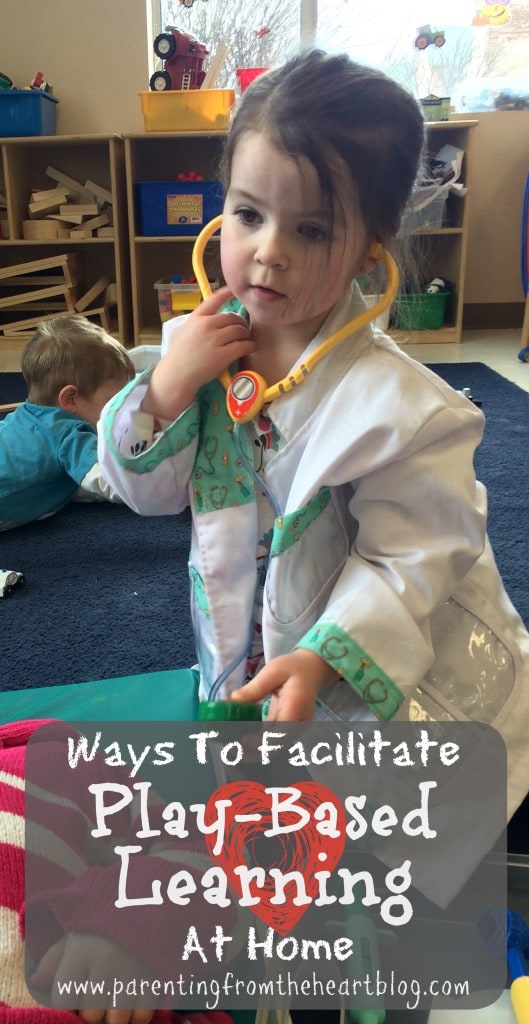There is such emphasis on play-based learning. But how does a parent facilitate play-based learning at home? Play-based…
There is such emphasis on play-based learning. But how does a parent facilitate play-based learning at home?
Play-based learning or learning through play is a seeming buzz-concept.
It is referenced in on Pinterest, in news articles, educational resources, and online talks. While it is universally agreed upon, it’s fair to wonder why play-based learning is so great.
Over and over again, research shows that children’s brains are developed through play. Specifically, their language, thinking and problem-solving skills are more advanced as a result of playing.
[P]lay-based learning leads to greater social, emotional, and academic success… In fact, play is considered to be so essential to healthy development that the United Nations has recognized it as a specific right for all children. – Council of Ministers of Education Canada
Play is an important vehicle for developing self-regulation as well as promoting language, cognition, and social competence… [Play] gives [children] opportunities to explore the world, interact with others, express and control emotions, develop their symbolic and problem-solving abilities, and practice emerging skills. Research shows the links between play and foundational capacities such as memory, self-regulation, oral language abilities, social skills, and success in school. – The National Association for Education of Young Children (USA)
While it is undeniable that play is crucial to a child’s learning, the question remains: how does a parent facilitate play-based learning at home?
The best way for a child to get the most out of learning through play is to be left to play at his or her own rate based on his or her interests. That said, there is so much we can do as parents to facilitate play-based learning at home. Here are some tips that come recommended by a school principal of over 35 years.

While technology can be a wonderful compliment to education, screen time should not be integral to a child’s learning. Even though the content may seem educational, there is a tremendous amount of evidence that using screen time as a substitute for reading or interacting with your child can be detrimental. (See one resource on this here)
You may have noticed in after a particularly busy day, you need to put your feet up and your child takes to playing. In letting them play by themselves, kids learn to self-regulate and are free to explore.
It can be tempting to control or coordinate play. However, child-directed play increases self-regulation and allows for more exploration and causal understanding.
Get down to their level. Play alongside them. The purpose of Child-Direct Play (CDP) is “[t]o enhance the child’s sense of appropriate control, self-regulation, and self-confidence; to provide an opportunity for the child’s access to focused, uninterrupted adult attention and close contact, without having to rely on negative or provocative behaviors to do so; and, to improve the level of understanding between the parent and child and the child’s sense of confidence and security in that relationship.” – Dr. McCurry Ph. D. (See more from this resource here).
Try just add a little more vocabulary or description to your child’s play. Be observant for their interests and add to their repertoire by adding something new to chosen favourites.
Different textures and colours add interest and peak curiosity
Tongs to pick up small items, oven mitts can be a makeshift puppet, a colander with pipe cleaners or dry pasta can act as wonderful sources of entertainment!
Outdoor play is also excellent for children as they learn cause and effect, appreciation of nature and benefit from fresh air. They also develop coordination and it is fun!
Through these opportunities, they learn to cooperate, negotiate, develop greater empathy, problem-solve and be kind.
Rain puddles, collecting natural items in nature a typical walk to the park more exciting and can lead to more fun once home!
photo credit: deposit photos
Giftedness isn’t just about acing spelling tests or finishing math worksheets early. Psychologists define it as an out‑of‑the‑ordinary…
Toddlers can be confusing, to say the least. One moment they’re clinging to your leg like a baby…
Wet days don’t have to mean bored little ones. With fun indoor kids activities on rainy days, you…